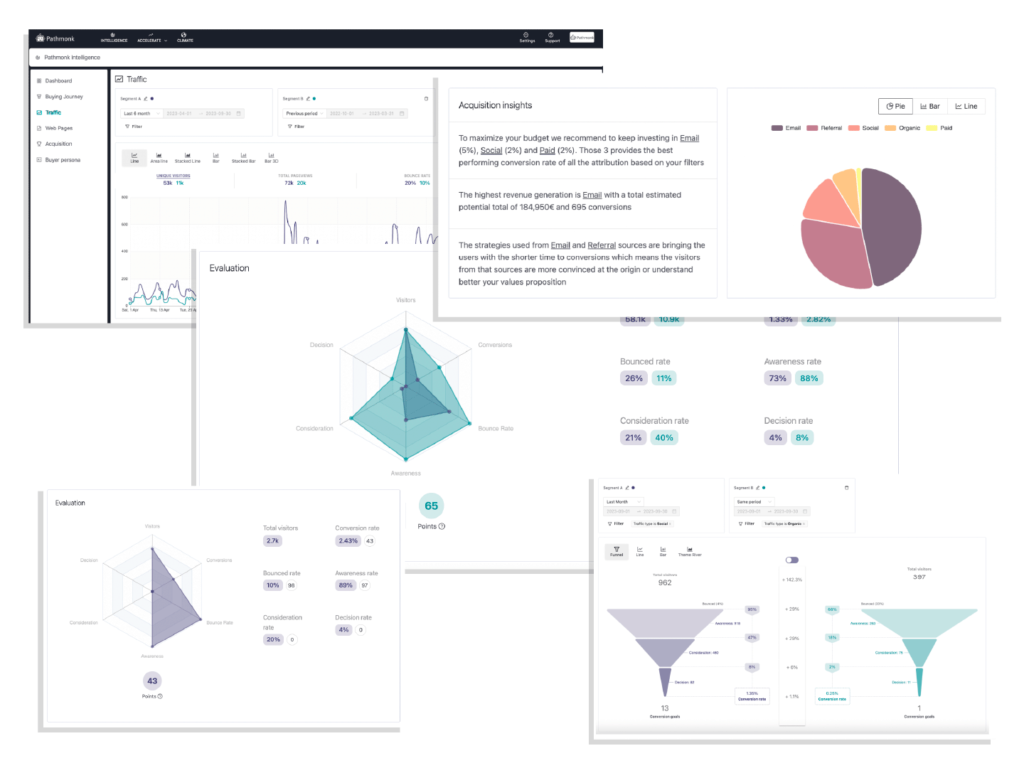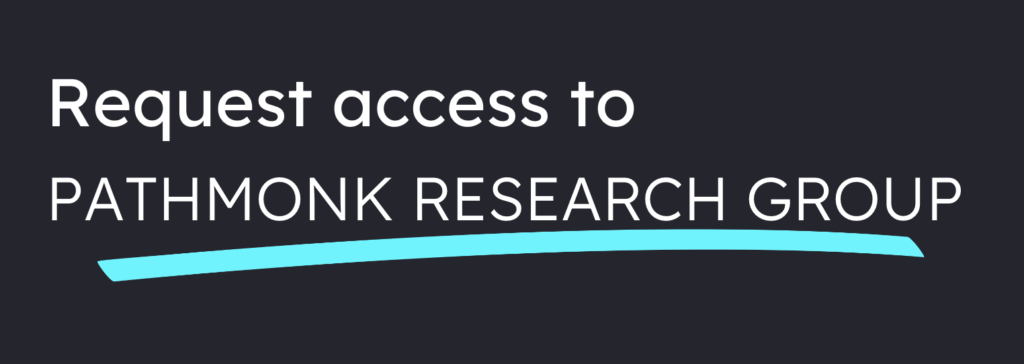How to Track Conversions Without Cookies with Pathmonk Intelligence

Marketers are constantly facing a dual challenge: the need to get accurate data and track conversions effectively while safeguarding user privacy. The traditional approach to conversion tracking, often reliant on cookies, is not only becoming increasingly outdated but also raises concerns about data privacy and user consent. Moreover, navigating the intricacies of tools like Google Analytics can be daunting, even for the most seasoned marketers.
Pathmonk Intelligence is a solution designed to address these pressing pain points and change how we track conversions. In this blog post, we’ll guide you step by step through the process of tracking conversions without cookies. With Pathmonk Intelligence, you can unlock accurate insights into user behavior and conversions while embracing a privacy-first approach, simplifying your tracking efforts, and improving the user experience.
Step by Step: Tracking Conversions Without Cookies with Pathmonk Intelligence
Tracking conversions is a fundamental aspect of any digital marketing strategy. Pathmonk Intelligence offers a robust suite of tools and reports to help you monitor user interactions and measure the effectiveness of your campaigns without the need for cookies, ensuring you are 100% compliant with all privacy regulations.
Here’s a breakdown of how to easily track conversions using Pathmonk Intelligence:
1. Define Conversion Goals:
When you’re creating your Pathmonk Intelligence account, set up conversion goals that align with actions on your website that indicate lead engagement within your buying journey. Examples include form submissions, email sign-ups, or purchases.
You have the flexibility to establish your goals using various methods: through a URL, a pixel that doesn’t rely on cookies, or by integrating with a third-party application.
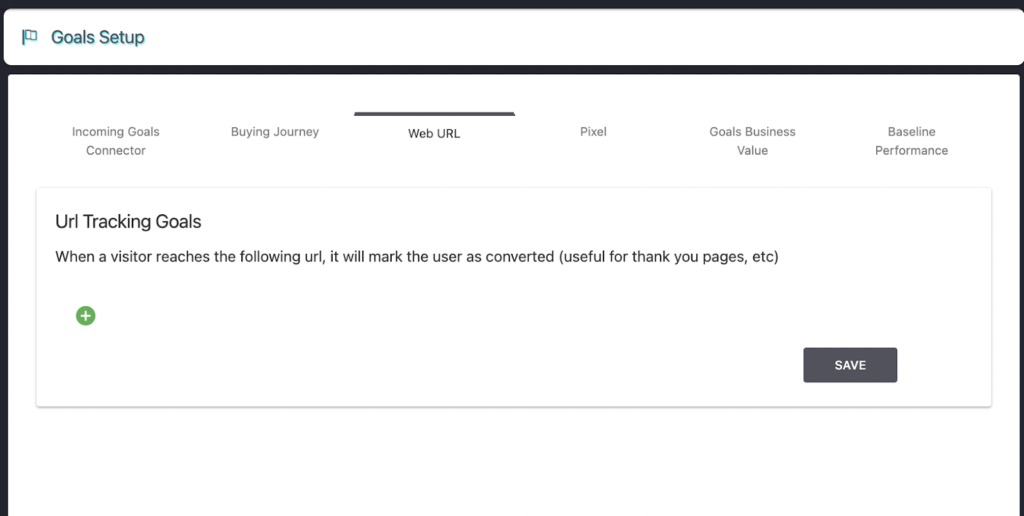
Other website analytics tools will require additional steps such as setting up custom dimensions and metrics to capture additional data. Pathmonk Intelligence algorithm, however, can monitor all user behavior on your website, such as page views, time spent on your website, click-through rates, and bounce rates. This enables Intelligence to understand exact intent in real-time so you don’t have to worry about creating any other parameters or tracking actions.
2. Analyze your Buying Journey’s Path to Conversions
Once you’ve configured your goal parameters, Pathmonk Intelligence will commence collecting data on user interactions, providing you with in-depth insights into your conversions. To access this information, navigate to the Buying Journey report located in the left-hand menu.
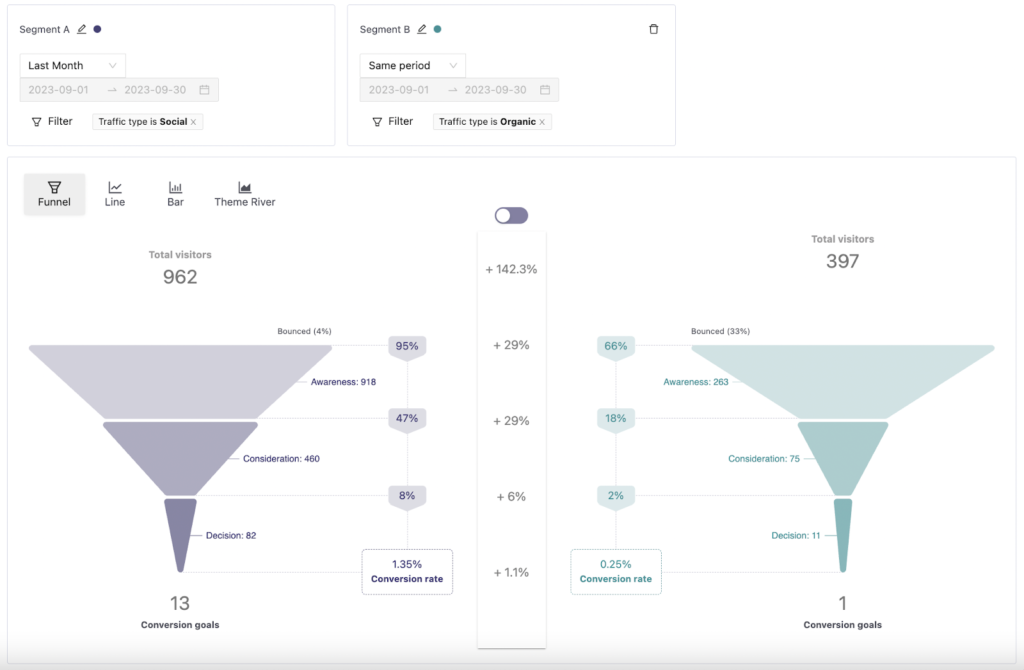
Within this report, you can tailor your analysis to suit your specific needs, choosing the time period that aligns with your objectives. Whether you wish to compare conversions over different time frames or contrast your overall buying journey with a particular source, channel, or campaign’s buying journey, Pathmonk Intelligence empowers you to do so effortlessly.
For instance, in the following example, we are comparing the general buying journey with that of the Organic channel over the same period. This comparative analysis can yield valuable insights into the performance of different pathways and assist you in making data-driven decisions to enhance your conversion strategies.
3. Understand Your Top Converting Pages
To gain more insights into your conversion performance, navigate to the Traffic report located in the left-hand menu. Once there, select the Top Conversions view. This filter is designed to present you with a clear and organized view of your conversions, showcasing the volume of conversions generated by each page and highlighting your best-performing pages at the top.
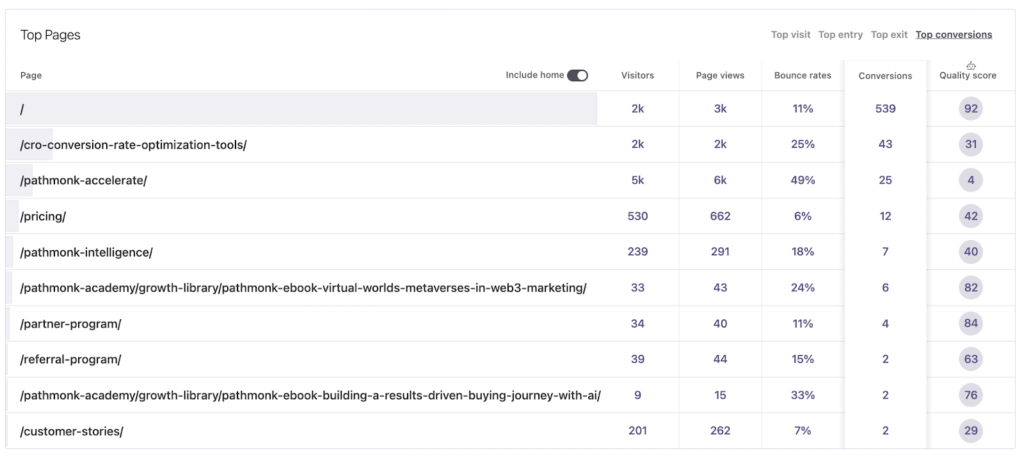
By leveraging this filter, you can identify which landing pages, messages, or other digital assets are proving most effective in driving conversions. This information is instrumental in optimizing your marketing strategy, allowing you to allocate resources to the areas that are contributing the most to your conversion goals. Understanding the strengths of specific pages or messages can lead to targeted improvements and ultimately better overall conversion rates.
4. Dive Deeper into your Conversion Data
Gain more comprehensive insights into your conversions with just a few clicks by heading to the Acquisition report.
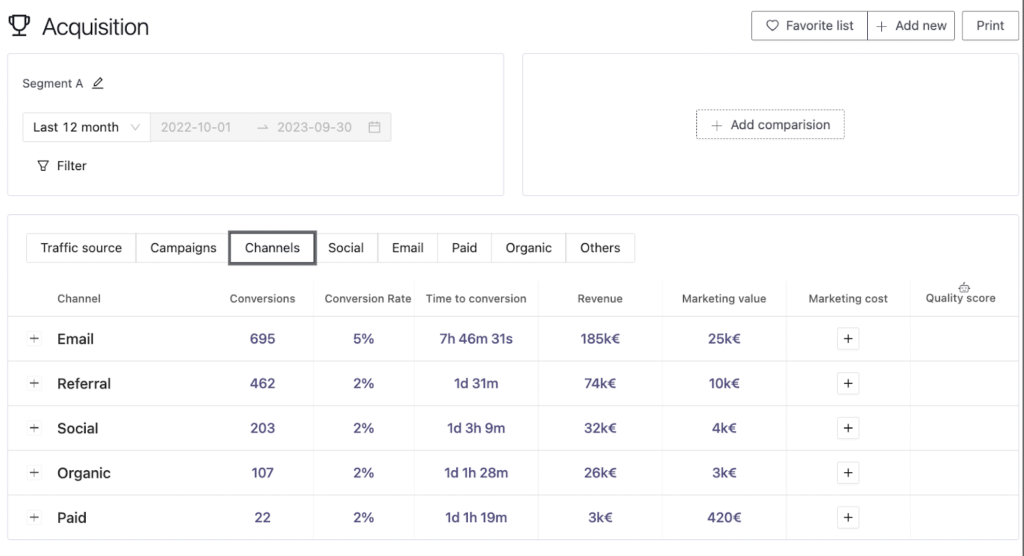
This resource provides you with detailed information about the performance of your various traffic sources, channels, and campaigns, including:
- Conversion Rates: Understand the conversion rate of each source, channel, and campaign. This knowledge helps you identify which avenues are delivering the highest return on investment.
- Time to Conversion: Analyze how quickly users are progressing from initial engagement to conversion. This insight aids in optimizing your marketing strategies for more efficient results.
- Revenue Generation: Track the revenue generated from different sources, channels, and campaigns. This data allows you to prioritize and allocate resources effectively to maximize your revenue.
- Marketing Value: Assess the overall marketing value of your conversions. This metric helps you gauge the effectiveness of your marketing efforts and their impact on your bottom line.
With these insights at your fingertips, you can optimize your marketing campaigns for enhanced performance and more significant business growth.
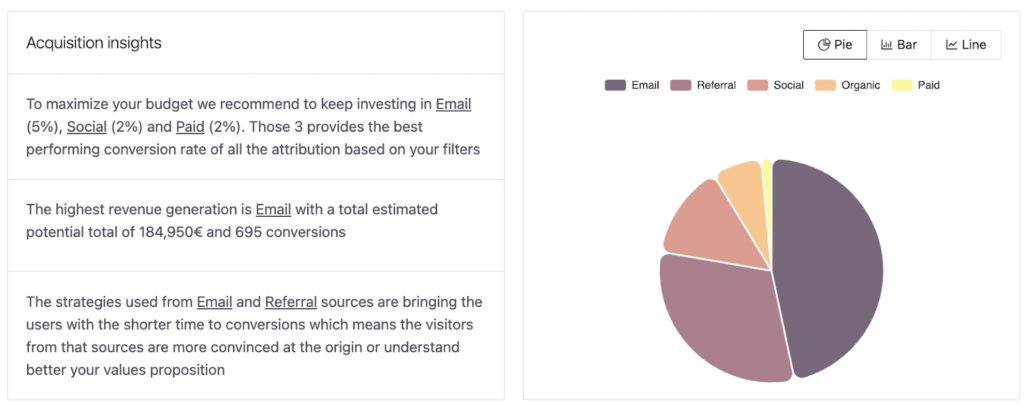
This report will also give you Acquisition insights, and automatically generated tips on how to maximize your resources based on the conversion signals received.
5. Understand How Your Buyer Persona Typically Converts
Delve into the Buyer Persona report and navigate to the Conversion Cycle section. Within this section, you will uncover detailed insights regarding how your typical buyer progresses toward conversion.
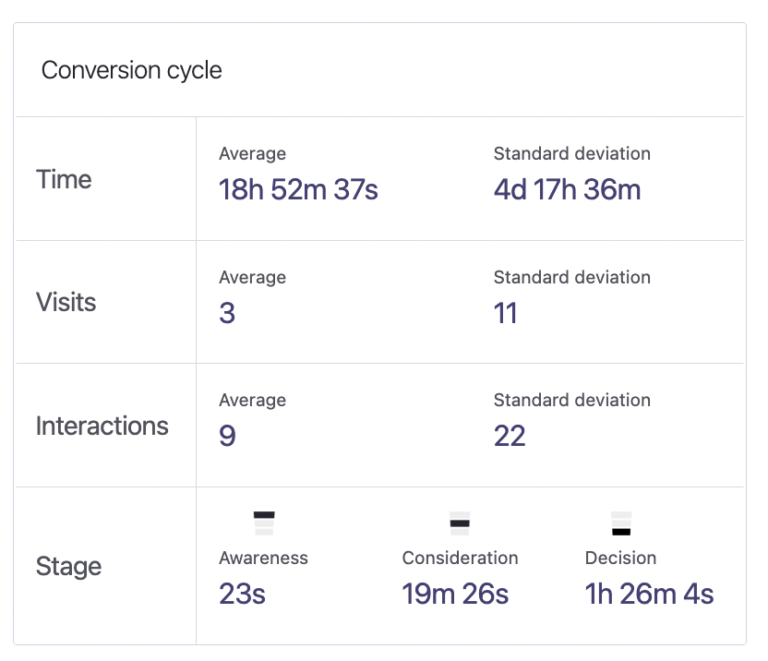
This information includes key metrics such as the average number of visits, touchpoints, and the time required for conversion. Additionally, it provides you with valuable data on the standard deviation, which is crucial for a comprehensive understanding of the conversion process.
The Importance of Tracking Conversions Without Cookies
Tracking conversions without cookies has become more than just a trend; it’s a necessity. Understanding the significance of this shift is crucial for marketers and businesses aiming to stay ahead in a rapidly evolving digital landscape.
These are some of the reasons why you, as a marketer, should start measuring your conversions without cookies:
1. Enhanced Privacy Protection:
Traditional cookie-based tracking methods often raise red flags in terms of privacy. Cookies can be perceived as invasive, as they track user behavior without explicit consent.
The rise of privacy regulations like GDPR and CCPA underscores the need for you to prioritize user privacy. Tracking conversions without cookies allows you to adopt a privacy-first approach, respecting users’ rights while still gathering valuable data.
2. Evolving Browser Restrictions:
Many web browsers have implemented features and settings that restrict or block cookies, making it increasingly challenging to rely solely on cookie-based tracking.
Safari, Firefox, and even Google Chrome have introduced privacy features that limit the effectiveness of cookies. By shifting to alternative conversion tracking methods, you future-proof your tracking capabilities against evolving browser restrictions.
3. Accurate Cross-Device Tracking:
With the proliferation of smartphones, tablets, and multiple devices per user, tracking conversions across devices has become paramount. Cookies struggle to provide accurate cross-device tracking, leading to fragmented and incomplete data.
Conversion tracking without cookies employs more sophisticated methods, ensuring a seamless and accurate view of user interactions regardless of the device they use.
4. Improved User Experience:
Excessive cookie usage can hinder the user experience by slowing down websites and triggering privacy concerns.
On the other hand, non-cookie tracking methods offer a smoother, less intrusive browsing experience. Users are more likely to engage with websites that respect their privacy, resulting in better retention rates and potentially increased conversions.
5. Reliable Data for Informed Decisions:
Accurate conversion tracking is the lifeblood of data-driven marketing. By embracing alternative tracking methods, you ensure that your data is dependable and reflective of user behavior.
This reliability enables you to make informed marketing decisions, allocate resources effectively, and optimize campaigns for better results.
Pathmonk Intelligence: The Solution for Tracking Conversions Without Cookies
Navigating the dynamic landscape of online marketing can be akin to traversing uncharted territory, with marketers encountering a multitude of challenges along the way. Pathmonk Intelligence is designed to provide a seamless and effective solution, addressing these pain points head-on.
- Cookieless Technology: Pathmonk Intelligence operates entirely without cookies, ensuring strict adherence to changing privacy regulations. This sets it apart from traditional analytics platforms, making it a trusted choice for user data protection.
- Simplifying Complex Analytics Tools: Marketers often find themselves grappling with the complexity of analytics platforms such as Google Analytics 4 and Tag Manager. Pathmonk Intelligence steps in as a user-friendly alternative, eliminating the need for coding or technical expertise. Marketers can now access valuable insights without the steep learning curve.
- Precise Attribution Modeling: Accurately attributing conversions to the right channels and campaigns remains an enduring challenge for marketers. Pathmonk Intelligence’s AI-powered algorithm steps into the game, offering precise attribution modeling. This simplifies the optimization of marketing efforts and leads to improved return on investment (ROI).
- Escaping Data Overload and Analysis Paralysis: Inundated by oceans of data, marketers often find themselves drowning in analysis paralysis. Pathmonk Intelligence streamlines data collection and presents actionable insights, providing a lifebuoy amid the sea of information. You can now make informed decisions without being overwhelmed.
- Automated Behavior Analysis: Setting up event tracking is frequently a laborious and technical undertaking. Pathmonk Intelligence, however, simplifies this process by automating behavior analysis, effectively cutting through technical overhead and saving valuable time.
How to Add Pathmonk Intelligence to Your Marketing Strategy
Step 1: Free Demo and Sign-Up
If you want a hands-on test of how Pathmonk Intelligence works and what it can do for you, sign up for a Free Demo. This hands-on experience will provide you with valuable insights into how Pathmonk Intelligence can work to your advantage.
Alternatively, you can directly start your journey with Pathmonk Intelligence by signing up for an account.
Step 2: Onboarding and Installation
Once registered, the next step is to integrate Pathmonk Intelligence with your platform.
The onboarding process has been designed to be exceptionally user-friendly, making it a self-service experience that ensures you’re up and running smoothly.
Step 3: Data Configuration
Your business is one-of-a-kind, and so are your objectives. We encourage you to customize your data collection settings to precisely align with your unique business goals. This level of customization empowers you to tailor your goals, ensuring that you receive the most relevant insights that will truly impact your success.
You have the flexibility to establish your goals using various methods: through a URL, a pixel that doesn’t rely on cookies, or by integrating with a third-party application.
Applying Pathmonk Intelligence Conversion Analysis to your Marketing Strategy
Now that you have harnessed the power of Pathmonk Intelligence to gain valuable insights into user behavior and conversions, it’s time to put this newfound knowledge to work. As a marketer, there are several key actions and strategies you should consider based on the outcomes derived from Pathmonk Intelligence conversion analysis:
- Allocate Resources Effectively: Armed with precise attribution data and ROI insights, you can allocate your marketing budget and resources more effectively. Shift investments toward channels, campaigns, or strategies that consistently yield high conversions and returns.
- Refine Targeted Messaging: Leverage the insights gained from conversion analysis to fine-tune your messaging. Tailor your content and communications to align more closely with the preferences and behaviors of your high-converting users.
- Optimize User Journeys: Use Pathmonk Intelligence data to optimize user journeys on your website. Identify bottlenecks or friction points in the conversion process and implement improvements to enhance the overall user experience.
- Testing and Experimentation: Implement A/B tests and experiments based on your conversion analysis findings. Test variations in content, design, and user flow to determine which elements resonate most with your audience and drive conversions.
- Personalization Strategies: Harness the power of personalization by segmenting your audience based on conversion behavior. Deliver tailored content and offers to specific user groups to increase engagement and conversion rates.
- Content Creation and Optimization: Create and optimize content based on conversion analysis findings. Tailor your blog posts, landing pages, and product descriptions to address the needs and pain points of your high-converting audience segments.
- Future Planning: Incorporate long-term insights from Pathmonk Intelligence into your strategic planning. Identify trends and opportunities that can shape your marketing strategy for the months and years ahead.
Exploring Pathmonk Intelligence Cookieles Conversion Tracking Use Cases
Pathmonk Intelligence’s cookieless conversion tracking opens up a world of possibilities across various industries, enabling you to measure conversions effectively while respecting user privacy.
These are some specific use cases highlighting the importance of tracking conversions in different industries:
eCommerce
- Shopping Cart Abandonment Reduction: Pathmonk Intelligence helps e-commerce businesses track users who abandon their shopping carts. By analyzing user behavior, you can implement strategies like personalized cart recovery emails, enticing discounts, or streamlined checkout processes to increase conversion rates.
- Product Recommendations: Leverage conversion data to offer personalized product recommendations based on user’s previous interactions. This approach not only boosts sales but also enhances the overall shopping experience.
SaaS (Software as a Service)
- Trial Conversion Rate Optimization: For SaaS companies offering free trials, tracking conversions is essential. Pathmonk Intelligence enables you to analyze user behavior during trials and identify factors that lead to successful conversions to paid subscriptions. This insight guides trial optimization strategies.
- User Onboarding Enhancement: By monitoring user interactions during the onboarding process, you can identify points where users drop off or convert. This data-driven approach allows you to refine onboarding sequences for higher conversion rates.
Healthcare
- Appointment Booking Efficiency: Healthcare providers can use conversion tracking to streamline appointment booking processes. Analyzing user journeys helps identify bottlenecks and allows for improvements that lead to higher appointment conversion rates.
- Telemedicine Adoption: In the era of telemedicine, conversion tracking has become vital for healthcare organizations. Pathmonk Intelligence assists in monitoring user engagement with telehealth platforms and optimizing the user experience to encourage more telemedicine appointments.
Education
- Course Enrollment Rates: Educational institutions can analyze conversion data to understand why prospective students do or do not enroll in courses. By identifying pain points or areas of interest, they can tailor marketing efforts and course offerings accordingly.
- Learning Resource Engagement: Tracking conversions in online learning platforms helps educators measure the effectiveness of learning resources. Insights into which resources lead to higher completion rates can guide content creation and curriculum design.
Real Estate
- Property Inquiry Conversions: For real estate agencies, tracking conversions is crucial for assessing the effectiveness of property listings. Understanding which listings generate the most inquiries allows agents to focus efforts on high-converting properties.
- Lead Nurturing: Conversion data aids in lead nurturing efforts. Real estate professionals can analyze user behavior to determine when and how leads convert into clients, allowing for more targeted follow-up strategies.
Intuitive Cookieless Analytics for Your Web
Understand your customer journey, find drop-offs, and receive actionable insights with AI.
